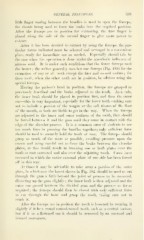Page 601 - My FlipBook
P. 601
GENERAL PRINCIPLES, 599
little finger resting between the handles is used to open the forceps,
the thumb being used to force the beaks into the required position.
After the forceps are in position for extracting, the first finger is
placed along the side of the second finger to give more power to
extract.
After it has been decided to extract by using the forceps, the par-
ticular forms indicated must be selected and arranged in a convenient
place, ready for immediate use as needed. Especially should this be
the case when the operation is done under the anesthetic influence of
nitrous oxid. It is under such conditions that the fewer forceps used
the better ; the writer generally uses but one forceps (Fig. 489) for the
extraction of any or all teeth except the first and second molars ; for
those teeth, when the other teeth are in position, he advises using the
special forceps.
Having the patient's head in position, the forceps are grasped as
previously described and the beaks adjusted to the tooth. As a rule,
the inner beak should be placed in position first, and then the outer
one—this is very important, especially for the lower teeth—taking care
not to include a portion of the tongue or the soft tissues of the floor
of the mouth, as both are liable to get in the way. When the forceps
are adjusted to the inner and outer surfaces of the tooth, they should
be forced between it and the gum until they come in contact with the
edge of the alveolar process. It is a common error of students to use
too much force in pressing the handles together; only sufficient force
should be used to securely hold the tooth or root. The forceps should
grasp as much of the roots as possible, avoiding pressure upon the
crown and being careful not to force the beaks between the alveolar
plates, as this would result in breaking one or both plates over the
tooth or root extracted and also over the adjoining tooth. Cases have
occurred in which the entire external ]>late of one side has been forced
off in this way.
At times it may be advisable to take away a portion of the outer
plate, in which case the lancet shown in Fig. 502 should be used to cut
through the gum a little beyond the point of process to be removed,
dissecting up the gum slightly ; the inner beak is then adjusted and the
outer one passed between the divided gum and the process as far as
required ; the forceps should then be closed with only sufficient force
to cut through the bone and grasp the tooth, taking care not to
crush it.
After the forceps are in position the tooth is loosened by rotating it
slightly if it be a round conical-rooted tooth, such as a central incisor,
but if it be a flattened one it should be removed by an outward and
inward movement.


